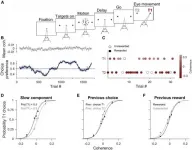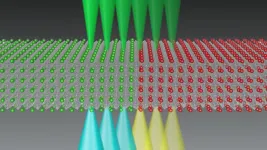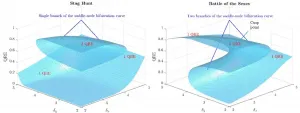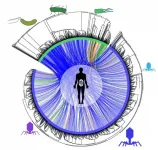(Press-News.org) People with aphantasia - that is, the inability to visualise mental images - are harder to spook with scary stories, a new UNSW Sydney study shows.
The study, published today in Proceedings of the Royal Society B, tested how aphantasic people reacted to reading distressing scenarios, like being chased by a shark, falling off a cliff, or being in a plane that's about to crash.
The researchers were able to physically measure each participant's fear response by monitoring changing skin conductivity levels - in other words, how much the story made a person sweat. This type of test is commonly used in psychology research to measure the body's physical expression of emotion.
According to the findings, scary stories lost their fear factor when the readers couldn't visually imagine the scene - suggesting imagery may have a closer link to emotions than scientists previously thought.
"We found the strongest evidence yet that mental imagery plays a key role in linking thoughts and emotions," says Professor Joel Pearson, senior author on the paper and Director of UNSW Science's Future Minds Lab.
"In all of our research to date, this is by far the biggest difference we've found between people with aphantasia and the general population."
To test the role of visual imagery in fear, the researchers guided 46 study participants (22 with aphantasia, and 24 with imagery) to a blackened room before attaching several electrodes to their skin. Skin is known to become a better conductor of electricity when a person feels strong emotions, like fear.
The scientists then left the room and turned the light off, leaving the participants alone as a story started to appear in the screen in front of them.
At first, the stories started innocuously - for example, 'You are at the beach, in the water' or 'You're on a plane, by the window'. But as the stories continued, the suspense slowly built, whether it was a dark flash in the distant waves and people on the beach pointing, or the cabin lights dimming as the plane starts to shake.
"Skin conductivity levels quickly started to grow for people who were able to visualise the stories," says Prof Pearson. "The more the stories went on, the more their skin reacted.
"But for people with aphantasia, the skin conductivity levels pretty much flatlined."
To check that differences in fear thresholds didn't cause the response, the experiment was repeated using a series of scary images instead of text, like a photo of a cadaver or a snake bearing its fangs.
But this time, the pictures made the skin crawl equally in both groups of people.
"These two sets of results suggest that aphantasia isn't linked to reduced emotion in general, but is specific to participants reading scary stories," says Prof. Pearson. "The emotional fear response was present when participants actually saw the scary material play out in front of them.
"The findings suggest that imagery is an emotional thought amplifier. We can think all kind of things, but without imagery, the thoughts aren't going to have that emotional 'boom'."
Living with aphantasia
Aphantasia affects 2-5 per cent of the population, but there is still very little known about the condition.
A UNSW study published last year found that aphantasia is linked to a widespread pattern of changes to other cognitive processes, like remembering, dreaming and imagining.
But while most previous aphantasia research focused on behavioural studies, this study used an objective measure of skin conductance.
"This evidence further supports aphantasia as a unique, verifiable phenomenon," says study co-author Dr Rebecca Keogh, a postdoctoral fellow formerly of UNSW and now based at Macquarie University.
"This work may provide a potential new objective tool which could be used to help to confirm and diagnose aphantasia in the future."
The idea for this experiment came after the research team noticed a recurring sentiment on aphantasia discussion boards that many people with the condition didn't enjoy reading fiction.
While the findings suggest that reading may not be as emotionally impactful for people with aphantasia, Prof. Pearson says it's important to note that the findings are based on averages, and not everyone with aphantasia will have the same reading experience.
The study was also focused on fear, and other emotional responses to fiction could be different.
"Aphantasia comes in different shapes and sizes," he says. "Some people have no visual imagery, while other people have no imagery in one or all of their other senses. Some people dream while others don't.
"So don't be concerned if you have aphantasia and don't fit this mould. There are all kinds of variations to aphantasia that we're only just discovering."
Next, Prof. Pearson and his team at the Future Minds Lab plan to investigate how disorders like anxiety and Post Traumatic Stress Disorder might be experienced differently by people with aphantasia.
"Aphantasia is neural diversity," says Prof. Pearson. "It's an amazing example of how different our brain and minds can be."
INFORMATION:
To be involved in this type of research and learn more about aphantasia and the Future Minds Lab, visit https://www.futuremindslab.com/aphantasia.
WESTMINSTER, Colorado - March 10, 2021 - The paperbark tree (Melaleuca quinquenervia) was introduced to the U.S. from Australia in the 1900s. Unfortunately, it went on to become a weedy invader that has dominated natural landscapes across southern Florida, including the fragile wetlands of the Everglades.
According to an article in the journal END ...
ften, humans display biases, i.e., unconscious tendencies towards a type of decision. Despite decades of study, we are yet to discover why biases are so persistent in all types of decisions. "Biases can help us make better decisions when we use them correctly in an action that has previously given us great reward. However, in other cases, biases can play against us, such as when we repeat actions in situations when it would be better not to", says Rubén Moreno Bote, coordinator of the UPF Theoretical and Cognitive Neuroscience Laboratory.
In these cases, decisions are guided by tendencies, or inclinations, that do not benefit our wellbeing. For example, playing the lottery more regularly after winning ...
Recent studies estimate that we use an astounding 129 billion face masks globally every month - that is 3 million a minute. Most of them are disposable face masks made from plastic microfibers.
- With increasing reports on inappropriate disposal of masks, it is urgent to recognize this potential environmental threat and prevent it from becoming the next plastic problem, researchers warn in a comment in the scientific journal Frontiers of Environmental Science & Engineering.
The researchers are Environmental Toxicologist Elvis Genbo Xu from University of Southern Denmark and Professor of Civil and Environmental Engineering ...
Global targets to improve the welfare of people across the planet will have mixed impacts on the world's forests, according to new research.
The United Nations' 17 key areas for global development - known as the Sustainable Development Goals (SDGs) - range from tackling poverty, hunger and sanitation to promoting clean energy, economic growth and reducing inequality.
Many of these goals, such as improved peace and justice, good health and wellbeing, and quality education, will have a positive impact on the Earth's natural forests.
But others, including creating new roads, industry and infrastructure, ...
Nearly 100 percent of the red snapper sampled in the Gulf of Mexico over a six-year period by University of South Florida (USF) marine scientists showed evidence of liver damage, according to a study reported in Aquatic Toxicology.
The study is the first to correlate the concentration of crude oil found in the workhorses of the digestive system -- the liver, gall bladder, and bile - with microscopic indicators of disease, such as inflammation, degenerative lesions, and the presence of parasites. The team sampled nearly 570 fish from 72 Gulf locations between 2011 to 2017 in the wake of the historic 2010 Deepwater Horizon oil spill.
"The results add to the list of other species we've analyzed indicating early warning ...
In a breakthrough for quantum computing, University of Chicago researchers have sent entangled qubit states through a communication cable linking one quantum network node to a second node.
The researchers, based in the Pritzker School of Molecular Engineering (PME) at the University of Chicago, also amplified an entangled state via the same cable first by using the cable to entangle two qubits in each of two nodes, then entangling these qubits further with other qubits in the nodes.
The results, published February 24, 2021 in Nature, could help make quantum computing more feasible and could lay the groundwork for future quantum communication networks.
"Developing methods that ...
"Phase transitions" are a central phenomenon in physical sciences. Despite being technical-sounding, they are actually something we all experience in everyday life: ice melting into liquid water, or hot water evaporating as steam. Solid, liquid, and gas are three well known "phases" and, when one turns into another, that is a phase transition.
Rare-earth nickelate oxides, also called nickelates, have attracted a lot of interest from researchers because they display an electronic phase transition, which may be exploited in future electronic devices. This particular phase transition consists of turning from a metallic ...
Game theory is known to be a useful tool in the study of Machine Learning (ML) and Artificial Intelligence (AI) Multi-Agent interactions.
One basic component of these ML and AI systems is the exploration-exploitation trade-off, a fundamental dilemma between taking a risk with new actions in the quest for more information about the environment (exploration) and repeatedly selecting actions that result in the current maximum reward or (exploitation).
However, the outcome of the exploration-exploitation process is often unpredictable in practice and ...
The balance of human intestinal microbiota, consisting of hundreds of bacterial species and phages (bacteria viruses), is crucial to good health. A research team, including scientists from the CNRS* and the Institut Pasteur, has characterised the phage-bacterial interaction networks of the microbiota in ten healthy individuals, with unprecedented precision. Scientists detected several hundred bacterial and phage genomes and identified the thousands of interactions that bind them by quantifying the contacts between the DNA molecules of viruses and their hosts. This method has the advantage ...
Researchers have published a study revealing their successful approach to designing much quieter propellers.
The Australian research team used machine learning to design their propellers, then 3D printed several of the most promising prototypes for experimental acoustic testing at the Commonwealth Scientific and Industrial Research Organisation's specialised 'echo-free' chamber.
Results now published in Aerospace Research Central show the prototypes made around 15dB less noise than commercially available propellers, validating the team's design methodology.
RMIT University aerospace engineer and lead researcher Dr Abdulghani Mohamed said the impressive results were enabled by two key innovations - the numerical algorithms ...








